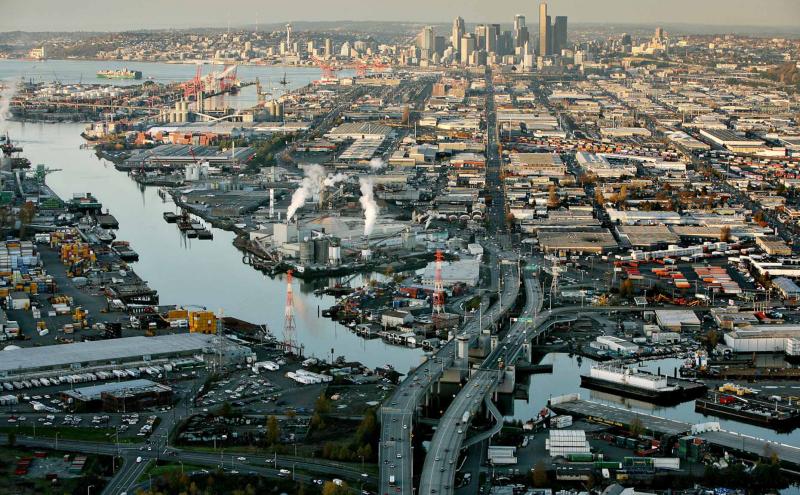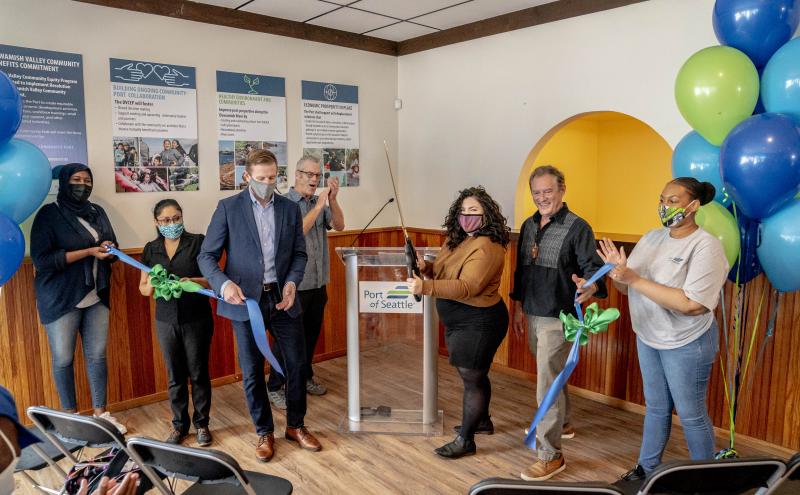
The Duwamish is Seattle’s only river. It provides important community assets, recreational fishing, and tribal cultural heritage resources, and is a critical estuarine environment for salmon and wildlife. The Duwamish has also played a crucial role in developing our region’s economy for over a hundred years: today local maritime and industrial businesses employ over 100,000 people and support more than 25 percent of the manufacturing in King County.
While none of the Lower Duwamish Waterway’s most contaminated areas are attributable to the Port or its tenants, the Port has made significant investments to improve conditions in the Duwamish River and the surrounding community.
The Port’s work includes financially supporting federal Superfund and state cleanups, restoring critical habitat, developing public access spaces, establishing the Duwamish Valley Community Benefits Commitment, and investing in the next generation of leaders through job training, internships, and partnership with the Highline School District’s Maritime High School.
Under the Superfund program alone, the Port of Seattle has spent more than $80 million to date on Lower Duwamish Superfund projects, including soil and in-water sediments cleanup at Duwamish River People’s Park (formerly known as Terminal 117) and subsequent habitat restoration; Lower Duwamish Waterway investigation and design; and cleanup and source control activities at adjacent upland facilities.
Opened in 2022, Duwamish River People’s Park became the largest habitat restoration and public access project completed on the Duwamish River in a generation. This 14-acre site not only provides critical habitat for threatened chinook salmon but has become a gem for the community, providing needed open space and river access for the South Park neighborhood.
To further support community needs, the Port established a community hub in South Park to provide meeting space, educational and job-training services, and more direct access to Port staff. The Port continues to invest in environmental programs aimed at habitat restoration, including restoring sustainable shorelines for salmon habitat wherever possible, exploring innovative solutions such as “biobarges,” and promoting the green jobs necessary to sustain this work for generations.
Lower Duwamish Waterway cleanup
The Port is pleased to see the cleanup moving forward with parties responsible for the pollution playing a leadership role in implementation.
The Environmental Protection Agency (EPA) listed the Lower Duwamish Waterway as a Superfund site in 2001 as a result of contamination stemming from nearly a century of industrial activities (including ship and plane manufacturing) and toxic discharges to the river. Primary contaminants of concern are polychlorinated biphenyls (PCBs), carcinogenic polycyclic aromatic hydrocarbons (cPAHs), arsenic, and dioxin/furans. In 2014, the EPA developed a detailed and comprehensive cleanup plan, called a Record of Decision (ROD), which along with early action area cleanups that have already occurred is expected to reduce contamination levels by at least 90 percent.
The Port initiated a groundbreaking partnership with King County, the City of Seattle, and The Boeing Company to investigate and address contamination at the Superfund site. For over twenty years, the Port has provided extensive staffing and financial resources toward the cleanup actions in the interest of ensuring that this work advanced, even though none of the Lower Duwamish Waterway’s most contaminated areas are attributable to the Port or its tenants.
The Port continues to fulfill its voluntary agreements related to the Lower Duwamish Waterway cleanup, including paying 25 percent of the costs for the design of the upper and middle reaches of the waterway.
More information and documents on the Lower Duwamish Waterway cleanup can be found on the Environmental Protection Agency’s Lower Duwamish Waterway website.
Frequently Asked Questions about the Duwamish River cleanup
Is it safe to eat fish caught in the Duwamish River?
There continue to be human health risks associated with eating resident seafood (i.e., fish and shellfish that live in the river year-round, such as crabs, sole, perch) from the river. The Port collaborates with the City of Seattle, EPA, and Public Health Seattle–King County to educate community members and fishers about the risks of consuming seafood from the Duwamish River. The Port recently worked directly with the fisher community to update a multilingual advisory sign that is now being installed by Public Health King County in local fishing areas. Community-based educators are teaching local fishers and nearby communities about safe fish preparation practices. This work will continue for several years after the cleanup has been completed.
Salmon are the healthiest choice because they only spend a short time in the waterway. Visit the Public Health Seattle–King County website for more information on catching and preparing fish caught from the Lower Duwamish Waterway.
What has the cleanup accomplished?
The cleanup of early action areas reduced PCB concentrations in the waterway sediments by 50 percent. The Port of Seattle’s early action project was Terminal 117, which is in the South Park neighborhood. This 14-acre site is not only serving as critical habitat for threatened chinook salmon but has become a gem for the community, providing needed open space and river access for the South Park neighborhood. Visit the Terminal 117 page to learn more about that cleanup and future plans for the site.
Who pays for the cleanup?
A core principle of Superfund law is the notion that a party with any responsibility for contamination, no matter how small, may be liable for the entire cleanup, no matter how significant. This is known as “joint and several” liability. This allows cleanups to proceed efficiently without potentially responsible parties delaying cleanup by arguing amongst themselves about how to split the bill. Parties can then work out their cost-sharing allocation separately, without impacting the scope or timing of cleanup. In the case of the Duwamish, the Port, City, County, and Boeing agreed to share costs on an equal 25% basis (subject to reallocation) while determining “fair shares” with other parties as part of a confidential mediation process. There are dozens of potential responsible parties who will pay shares based on their relative contribution of contamination to the waterway, among other factors. The Port will continue to advocate that those who polluted the waterway pay their fair share for the cleanup.
How is this project connected to other Superfund cleanups?
The Lower Duwamish Waterway flows north to Harbor Island, where the river splits into the West and East Waterways and discharges into Elliott Bay. Harbor Island is a human-built, industrial island in Elliott Bay. Built in the early 1900s, the 420-acre island supports commercial and industrial businesses. Prior operations at the site resulted in contamination, leading the EPA to list the Harbor Island Superfund Site as one of the very first Superfund sites in the country in 1983.
The EPA divided the Harbor Island site into seven smaller areas, known as “Operable Units” (OUs), to better implement site cleanup. Cleanups have been completed at six of the OUs, and the only remaining OU for cleanup is the East Waterway. The Port is leading the East Waterway cleanup, acting in partnership with the City of Seattle and King County. Visit the East Waterway page for more information about that site.









